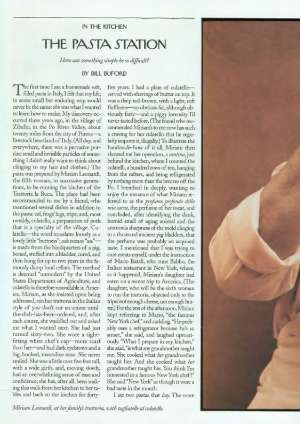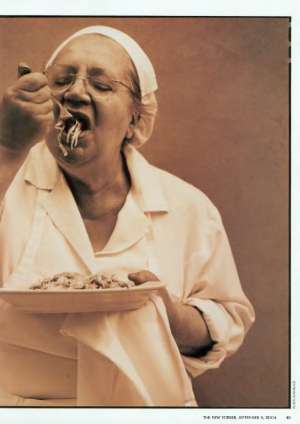The New Yorker, September 6, 2004 P. 114
IN THE KITCHEN about the writer’s experience working at the pasta station in Mario Batali’s Italian restaurant, Babbo. The writer first tasted homemade Italian pasta 3 years ago in Zibello, in the Po River Valley, about 20 miles from Parma. The pasta was prepared by Miriam Leonardi, the 5th woman, in successive generations, to be running the kitchen of the Trattoria la Buca. Mentions culatello. Miriam made fun of chef Mario Batali, of New York’s Babbo restaurant, for using a freezer to prepare pasta. “What I prepare in my kitchen,” she said, “is what my grandmother taught me.” Europe’s first cookbook best-seller, “De Honesta Voluptate et Valetudine” (“On Right Pleasure and Good Health”), written in 1465 by Platina, contained many of 15th-century Italian chef Maestro Martino’s recipes for torta, or stuffed noodles. When the writer returned to New York after visiting Miriam’s trattoria, he approached Mario Batali, the genius behind some of the best pasta in New York, and asked to work at the pasta station at Babbo. There, the pasta was made during the day and then the preparation (cooking and saucing) was done, to order, in the evening. The writer began at Stage One-making pasta-and his first task was to make hundreds of orecchiette. The writer learned the texture and shapes of the various pastas. Compares pasta to belly buttons: there are innies and outies. About half of the Babbo pastas were stuffed. When he was finally allowed to work at the pasta station in the evening, the writer found a cheat sheet taped to the wall. Describes the centuries-long rivalry between French-cuisine advocates and Italian-cuisine advocates. Discusses Bolognese ragu sauce-the varieties and how it’s made. Mentions Gianni and Betta Valdiserri. A filled pasta was rarely combined with a ragu. Mentions Babbo sous-chef Frankie Langello and Mark Barrett. Describes the effect of “emulsions” on pasta. Tells how to prepare a butter sauce with tortelloni. Notes how the writer was once caught in mid-reverie while making a mushroom sauce. In all these dishes was an ingredient you can’t get at home: the restaurant’s pasta water. Describes the pasta water and how to clean the extremely hot pasta cooker. Tells about an impromptu late-night family meal which featured a big platter of linguine with clams. The writer usually avoided shellfish pasta dishes. He was having trouble with that instantaneous, unreflected recall required by the pasta station. Describes the kitchen staff’s dislike of Babbo’s maitre d’, John Mainieri, because he sometimes accepted late seatings. At Babbo, the writer learned that a meal was about the interaction between a pasta and a sauce. Babbo’s linguine with clams evoked a childhood trip to the sea. The only ingredient that’s measured in the restaurant is the pasta; everything else is added with a pinch of your fingertips. Describes how cookbook measurements often don’t precisely reflect how restaurant dishes are prepared. Tells how to make linguine with clams at home. After working at the pasta station, the writer phoned Miriam Leonardi and was shocked to discover that she now uses a machine to prepare pasta.

